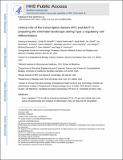Critical role of IRF1 and BATF in forming chromatin landscape during type 1 regulatory cell differentiation
Author(s)
Karwacz, Katarzyna; Miraldi, Emily R; Pokrovskii, Maria; Madi, Asaf; Yosef, Nir; Wortman, Ivo; Chen, Xi; Watters, Aaron; Carriero, Nicholas; Awasthi, Amit; Bonneau, Richard; Littman, Dan; Kuchroo, Vijay K; Regev, Aviv; ... Show more Show less
Downloadnihms957355.pdf (2.604Mb)
OPEN_ACCESS_POLICY
Open Access Policy
Creative Commons Attribution-Noncommercial-Share Alike
Terms of use
Metadata
Show full item recordAbstract
Type 1 regulatory T cells (Tr1 cells) are induced by interleukin-27 (IL-27) and have critical roles in the control of autoimmunity and resolution of inflammation. We found that the transcription factors IRF1 and BATF were induced early on after treatment with IL-27 and were required for the differentiation and function of Tr1 cells in vitro and in vivo. Epigenetic and transcriptional analyses revealed that both transcription factors influenced chromatin accessibility and expression of the genes required for Tr1 cell function. IRF1 and BATF deficiencies uniquely altered the chromatin landscape, suggesting that these factors serve a pioneering function during Tr1 cell differentiation.
Date issued
2017-02Department
Broad Institute of MIT and Harvard; Massachusetts Institute of Technology. Department of BiologyJournal
Nature Immunology
Publisher
Nature Publishing Group
Citation
Karwacz, Katarzyna et al. “Critical Role of IRF1 and BATF in Forming Chromatin Landscape During Type 1 Regulatory Cell Differentiation.” Nature Immunology 18, 4 (February 2017): 412–421 © 2017 Nature America Inc, part of Springer Nature
Version: Author's final manuscript
ISSN
1529-2908
1529-2916